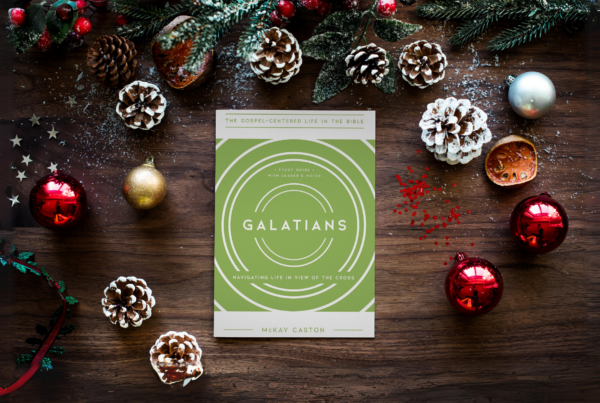Love knows no limit to its endurance, no end to its trust, no fading of its hope; it can outlast anything. It is, in fact, the one thing that still stands when all else has fallen.
—><—
Roll these words around in your mind: “No limit to its endurance, no end to its trust, no fading of its hope.”
It is hard to imagine that something as tender as love could have this much tenacity.
The poetry of Paul to the Corinthian church states that love still stands when all else has fallen. But baked into the assurance that love remains is the reminder that nothing else will.
As I celebrate Advent, it’s been good to remind myself that what I stand on really matters.
I don’t want to stand on counterfeit loves even though I’m surrounded by them, and they look so appealing. But even surrounded by counterfeits, we can see the real thing in the Bible. God isn’t coy. His love is prodigal and threads through all of redemptive history. Don’t think of a fancy gold thread or a musical motif. Instead, think of a guy wire.
A guy wire is a cable or rope first used to fix a furled sail to a mast. It’s a cord of twisted strands that is both lightweight and strong.
I love this description from a parts catalog – “a twisted strand of incredible strength.” Guy wires are designed to bear high tension and stabilize structures that aren’t otherwise able to support themselves.
Woven from before the beginning, and continuing past the end, the love of God is the “guy wire” that runs through all of scripture.
Love is Grounded in the Character of God
“In the beginning, God…”
Even before the wonder and power of creation, there was love in the Father, Son, and Spirit.
Love is the guy wire of the Trinity, perfect as both Lover and Beloved – eternally full of glory and eternally giving the glory to one another.
In The Screwtape Letters, C.S. Lewis flips the lens to see the Trinity as a conundrum that violates every rule of hell:
“My good is my good, and your good is yours. What one gains another loses,” explains a senior devil to his nephew in the fictional letter exchange. “Now the enemy’s (God’s) philosophy is nothing more nor less than one continued attempt to evade this obvious truth… Things are to be many yet somehow also one. The good of oneself is to be the good of another. This impossibility He calls Love,” the senior tempter writes.
“He claims to be three as well as one, in order that this nonsense about Love may find a foothold in His own nature.”
Foothold, indeed. It’s incomprehensible to us, but eternal friendship and nothing less is the love we are called into.
“In the beginning, God created…”
When poets and pop stars tell us that love is the strongest force in the world, it actually makes sense. Creation was derived from love, so the guy wire that begins in the Trinity starts to thread darkness and light, sky and water, land and sea.
When Adam and Eve rejected their relationship with God, they veered away from love immediately. Their relationships curdled into blame and fear, exchanging a love with “no end to its trust” for a fig leaf.
But love didn’t change.
It looped around Noah, and led Abraham out of Ur and into the Canan. It called a family into a nation and supported it through the crush of slavery.
In all the moments that the wire seemed to go slack or disappear, the prophets whispered the love of God, the promise of healing, and that one day there would be a redeemer.
“In this the love of God was made manifest among us, that God sent his only Son into the world, so that we might live through Him” (1 John 4:9).
Love Runs Through a Manger
In Bethlehem, hospitality was either so overwhelmed by census bureaucracy or so atrophied that no one would make room for a woman about to give birth.
We don’t know what the Christmas manger scene looked like exactly, despite Hallmark’s estimated 3,600 different Christmas designs. But what the gospel writer Luke points out is that God comes to a people who do not welcome him.
Love doesn’t meet indifference with indifference of its own. Instead, love bombards indifference with glory.
It is heavenly armies and choirs, angelic proclamations, a star, exotic visitors with more-than-exotic gifts.
Paul writes in his letter to the people in Colossia that, in Christ, the exact image of the invisible God became visible.
The One who wrapped the night sky in stars was wrapped in cloth in a manger. The One who holds the universe wove Himself into us.
Love Shines at the Cross
It’s Christmastime, so it feels strange to write about Easter (like I got confused about which holiday we are celebrating) but the tensile strength of love shines brightest just when it seems like love has unraveled.
Jesus certainly seems like a man abandoned by God. “He saved others,” they said, “but he can’t save himself! He’s the king of Israel! Let him come down now from the cross, and we will believe in him. He trusts in God. Let God rescue him now if he wants him, for he said, ‘I am the Son of God.’” the crowd taunted (Matt. 27).
And then the anguish of His own words: “My God, my God, why have you forsaken me!?” makes it seem like the guy wire has finally encountered a pressure it can’t bear as the Father’s wrath is poured out.
It’s a lot to take in, but ponder this as well: this cry of anguish is also a sign of divine unity.
What looks like a visible fray in God’s love, is the visible unity as God the Father, Son, and Spirit together make a way for the debt of sin to be paid.
Love holds together while the veil in the temple is torn in two.
A few years ago, I asked my junior high Sunday school class why God went through this…
If God was perfect in love and unity on Maundy Thursday and perfect in love and unity on Easter morning, why the cross?
There was a long, junior-high pause, and one of the kids asked, “To prove a point?” (lots of work to do in that class…). But I ask you the same question: Why the anguish of the cross?
To weave you in.
To bring you into relationship. Not mechanically gripped between wires, but rescued from what is crumbling and woven into a love that will outlast anything.
To continue Jesus’ invitation of “follow me“ into the eternal welcome of God. Or as Rev. Howard Brown wrote at the start of our Advent series:
“Our hope in waiting on the Lord is that the Lord Himself, in order to renew us, waits on us. He’s bound himself to fallen, failing, and exhausted people, those who couldn’t wait on Him.
And it’s a promise, not just a possibility – it’s a promise of God’s renewal in Christ Jesus…
He has come to bind himself to humanity. He has come to connect to failed, fainting, fallen off, ruined, and run-down souls and lives. His birth, life, death, and resurrection for people like you and me means that God will never tire, faint, or fail in waiting on us.”
How do we renew our love?
How does the “guy wire” change us in Advent? How can we respond to what love has done for us? I think we answer His love by echoing it.
We fix our eyes on the Love that endures…
We remember the guy wire has already held up to the pressure and proven stronger than sin and death. I try to “be more loving” through my own effort, but my love rarely proves stronger than an inconvenience.
We love what He loves…
God loves you. Not the ultramarathon runner, Ph.D. candidate, concert pianist, never-makes-a-mistake you (or whatever image of yourself that you could ever possibly love).
Sometimes this cornerstone of the gospel, that God loves us, is the hardest part to believe.
Camp out in the love God has for you, and really take in “ that Christ may dwell in your hearts through faith — that you, being rooted and grounded in love, may have strength to comprehend with all the saints what is the breadth and length and height and depth, and to know the love of Christ that surpasses knowledge, that you may be filled with all the fullness of God” (Eph. 3).
We love one another…
But – and you knew this part was coming – the guy wire doesn’t end at you. It moves.
It moved Mary and Joseph to trust an angel’s announcement that they couldn’t understand and moved them to Egypt and back. Love led Peter to become a street preacher and sent Paul to the Gentiles.
For thousands of years, love has moved God’s people to Kingdom work and prayer.
Our paths are uniquely circuitous, but the destination is always the same.
God moves us to our neighbors and into a hurting world, working through us to heal the brokenness around them.
Love Leads Us to the Table
Throughout Advent, we recognize the weight of waiting.
Earlier in our Advent series, Lindsay Kimball wrote, “this Advent season of sitting in darkness and waiting for the light to come, we live in between the reign of peace ushered in by the baby in Bethlehem, and the final realization of peace in full, in the renewing of all things.”
But as we wait and wrestle with frayed lives in a frayed creation, Lindsay notes that these could be ways that God is calling us to feast on Him in deeper ways.
As hopeful people who can already smell the grass of the new heaven and new earth.
As peacemakers who find perfect security in Christ.
As joyful people who are not content to play with mud pies but seek the greater joy of Christ.
And as loving people who understand that “the end of all things” is just the beginning. Love doesn’t end when the brokenness is finally healed.
Love waits with us until all the saints are seated at the table so the party can finally get started.
The guy wire continues – not just “dropping us off” as if getting us to the table alone is the end of the story. “No limit to its endurance, no end to its trust, no fading of its hope” means that God’s love carries us eternally.
A Meditation for Advent:
Hark! The herald angels sing
“Glory to the newborn King”
Peace on earth and mercy mild
God and sinners reconciled
Joyful all ye nations rise
Join the triumph of the skies
With angelic host proclaim
Christ is born in Bethlehem
With angelic host proclaim
Christ is born in Bethlehem
Mild He lays His glory by
Born that man no more may die
Born to raise the sons of Earth
Born to give them second birth
Veiled in flesh the Godhead see
Hail the incarnate deity
Pleased as man with men to dwell
Jesus, our Emmanuel
Pleased as man with men to dwell
Jesus, our Emmanuel
Hail the Heaven-born Prince of Peace
Hail the Sun of Righteousness
Light and life to all He brings
Risen with healing in His wings
Christ, the highest heaven adore
Christ, the everlasting Lord
Come, Desire of Nations, come
Fix in us Thy humble home
Come, Desire of Nations, come
Fix in us Thy humble home
————————–
This blog post is part of a five-part Advent devotional series, centered on asking Jesus to renew our Hope, Peace, Joy, and Love:
November 26 – The Lord Who Waits on Us (by Rev. Howard Brown)
November 28 – Renewing Our Hope (by Scotty Smith)
December 5 – Renewing Our Peace (by Lindsay Kimball)
December 12 – Renewing Our Joy (by Dr. Robert Kim)
Catch up on the whole series at: serge.org/renewal-for-advent






